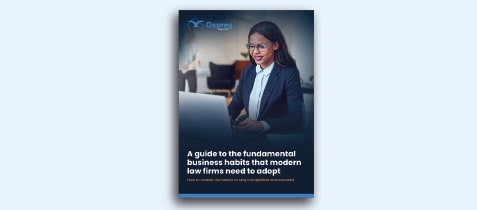Contents
How to be CQS Compliant part 3: The 10 common compliance pitfalls most SME law firms face and how to overcome them
In collaboration with InfoTrack and Tracy Thompson – lead assessor for CQS – our three-part guide aims to help law firms meet CQS Core Practice Management Standards and stay compliant. In part three, this guide covers the common compliance pitfalls SME law firms typically face and how to overcome them.

The 2022 changes to the CQS accreditation that your firm needs to know
The Law Society published several changes and updates to the Conveyancing Quality Scheme (CQS) in May 2022 that affects over 3,000 law firm across the UK.
The latest version of the CQS Core Practice Management Standards (CPMS) is now aligned with the Lexcel accreditation. So, if you’re Lexcel accredited then you should already meet approximately 50% of the requirements. The CQS CPMS now has seven chapters and an increase to 40 individual requirements.
For a detailed guide on the recent changes to the CPMS, you can view part one of our how to be CQS Compliant guide here.
10 compliance pitfalls most SME law firms face and how to avoid them
As a CQS and Lexcel assessor and consultant, Tracy has seen it all over the years.
After consulting for hundreds of SME law firms, Tracy has highlighted the common non-compliance mistakes she sees on a regular basis and advises on how to avoid them in your own firm.
- Business continuity plan
Firms typically don’t have a documented procedure for how they will test their business continuity plan if the worst should happen. It’s a requirement to have a procedure for annual testing which should document how you’ll test the success of your business continuity plan and how you’ll evidence the test. Simply having a conversation with key members of the team to test various business interruption scenarios is a simple way to meet this requirement. Ensure the scenarios testing conversation is documented.
2. Financial verification procedures
There are several financial verification processes that firms aren’t documenting or evidencing well enough, including checking bank accounts of other parties and the procedure for authorising paying out funds. Make sure these circumstances are considered within your documentation.
For example, many risk assessments state firms don’t act for high-risk third countries but actually they might be dealing with a client that lives in the UK, but their money is coming from a high-risk third country. That’s typically something that is overlooked when completing risk assessments.
Using the InfoTrack integration with Osprey you can complete your AML checks digitally and the results are automatically saved to the matter history to track your checks.
3. AML
Often firms have not updated their Anti-Money Laundering Practice-Wide Risk Assessment. The Legal Sector Affinity Group (LSAG) guidance was updated in March 2023, which should have been a catalyst to update the policy. Considerations need to be given to the current risks and trends, such as the firms approach to acceptance of cash and cryptocurrency and the Russia Ukraine conflict.
Two further key areas of non-compliance that Tracy also sees in firms is relating to matter-level AML Risk Assessment, for example, not documenting a source of wealth analysis, and not having an independent AML audit function in place.
Practices often don’t consider they’re big enough for an independent audit function. However, the SRA stated in their AML annual report in October that approximately 50% who took that stance ought to have had the audit function in place. Unless you’re a sole practitioner, the SRA expects firms to give serious consideration to having an independent audit carried out.
Additionally, if you don’t have an appointed MLCO, Tracy recommends firms review that.
4. Property and mortgage fraud policy
Typically, Tracy sees policies that were created years ago, so make sure your policies are relevant. Importantly, make sure the matter-level fraud risk assessment is in place and ensure checking the other side’s conveyancer is evidenced.
5. Conflict policy
Often, policies don’t make it clear whether the firm acts for both sides in a transaction, and who can authorise. Often, we see silent policies that don’t state either way, but Tracy recommends making that clear, state why you’ve taken that stance and what steps you’re taking to mitigate the risk of conflict if you do act for both parties.
6. SDLT procedures
There’s often a lack of reference and awareness to LTT which can cause errors in the SDLT calculation, which is often only spotted at the end of a matter. A second pair of eyes on the calculation verifying the calculation is useful to mitigate this, but ensure you’re evidencing that the check was completed. This is required in all purchases where LTT or SDLT is a consideration.
Automated workflows within Osprey can help to implement prompts and checks to help standardise the process and ensure all fee earners are following procedure.
7. Leasehold and freehold explanations
Sending a 17-page document and advising to comply with the restrictions in schedule four on page ten isn’t good enough. It’s important to provide and explain the details and give full clear advice.
8. Reporting to lenders
Firms often aren’t recording that part two checks of the UK Finance Handbook are being completed. Ensure policies document how and what you’re reporting to lenders.
9. Closing letters
A lot of firms haven’t yet referred to the HMLR Property Alert Service in their closing letters which must be added.
Editing document templates is simple within Osprey. Easily edit your client care and closing letter templates to ensure they meet the CPMS standards and then simply make them available for all fee earners to use as they need so you can be confident everyone is following procedure.
10. Avoiding HMLR requisitions
Tracy doesn’t often see procedures in place for how fee earners can proactively avoid HMLR requisitions, which can often be quick and simple to implement.
How your law firm can be CQS compliant
To ensure you’re assessment ready Tracy recommends that firms follow her simple three tier process to mitigate risk:
- Say as you do (documented policies & procedures)
- Do as you say (ensure those documented policies and procedures are being followed in practice)
- Provide the evidence (track and document your compliance checks and reviews)
When an assessor is reviewing your policies and procedures to check they the meet the CPMS requirements, remember that crucially they will also look for evidence that your firm is following this in practice. Assessors will conduct a number of interviews and file reviews which is why step three – providing evidence – is so important.
Utilising legal tech and digital tools to stay CQS compliant
Managing these requirements manually is an impossible task, especially when you have growing teams. Relying on our case management software and digital conveyancing tools can help to streamline the process for you and automatically implement these quality measures and checks throughout the process. This provides management with confidence that compliance procedures are being followed.
For further advice and best practice you can also view parts one and two of our CQS guide:
A guide to the new updates to the CQS Practice Management Standards
10 ways Osprey & InfoTrack can help law firms stay CQS compliant
Or you can watch the full on-demand webinar here with InfoTrack and Tracy Thompson.





